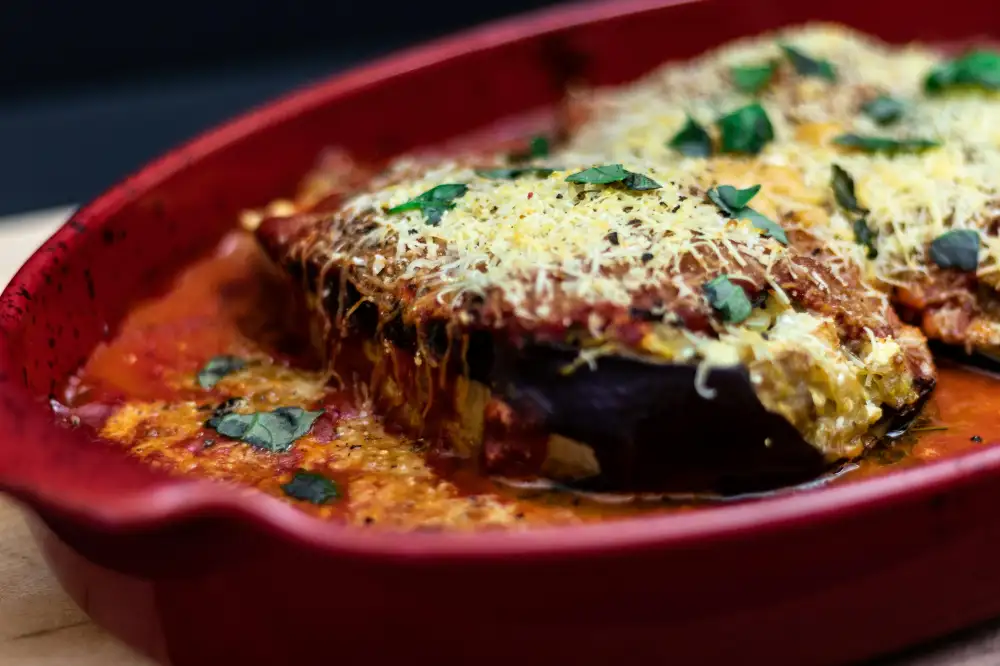Deliciously Versatile: Unleashing the Magic of Aubergine in Your Kitchen - A Must-Try Recipe!

Aubergine, also known as eggplant, is a versatile and delicious vegetable that is widely used in cuisines around the world. With its deep purple skin and creamy flesh, it adds a unique flavor and texture to dishes. Originally native to India, aubergine has been cultivated for thousands of years and has become an integral part of Mediterranean, Middle Eastern, and Asian cooking. Whether grilled, roasted, or sautéed, this vegetable offers endless possibilities for creating mouthwatering dishes that will delight your taste buds.
Health Benefits of Aubergine
Aubergine, also known as eggplant, is not only a versatile and delicious vegetable but also packed with numerous health benefits. This purple beauty is low in calories and fat, making it an excellent choice for those watching their weight. It is also a good source of dietary fiber, which aids in digestion and helps maintain a healthy digestive system.
One of the standout health benefits of aubergine is its high antioxidant content. These antioxidants, such as nasunin, help protect the body against free radicals that can cause damage to cells and contribute to chronic diseases like cancer and heart disease. Additionally, aubergines are rich in phytonutrients like chlorogenic acid, which has been linked to reducing inflammation and improving blood sugar control.
Aubergines are also a great source of vitamins and minerals. They contain vitamins B6, C, and K, as well as minerals like potassium and manganese. Vitamin B6 plays a crucial role in brain development and function, while vitamin C boosts the immune system and promotes collagen production for healthy skin.
Furthermore, the skin of the aubergine contains anthocyanins, which have been associated with improved cognitive function and reduced risk of age-related mental decline.
Incorporating aubergines into your diet can offer these incredible health benefits while adding flavor and variety to your meals. So why not give this versatile vegetable a try? Your taste buds and your body will thank you!
Different Varieties of Aubergine
Aubergine, also known as eggplant, comes in a variety of shapes, sizes, and colors. The most common type is the large purple variety, which is widely available in supermarkets. However, there are many other interesting varieties to explore.
One popular variety is the Japanese eggplant, which is long and slender with a dark purple skin. It has a mild flavor and tender texture, making it perfect for stir-fries and tempura.
Another unique variety is the white eggplant, which has a creamy white skin and a slightly sweeter taste than its purple counterpart. It is often used in Mediterranean dishes such as moussaka or roasted with garlic and herbs.
The Graffiti eggplant is another eye-catching variety with its vibrant purple and white striped skin. It has a firm texture and can be grilled or roasted to bring out its smoky flavor.
For those looking for something different, there are also mini or baby eggplants available. These small-sized varieties come in various colors such as green, yellow, or even striped. They are great for stuffing or pickling.
With so many different varieties to choose from, experimenting with aubergine in your cooking can be both exciting and rewarding. Each variety offers its own unique taste and texture, allowing you to unleash your creativity in the kitchen.
Tips for Buying and Storing Aubergine
When buying aubergines, look for ones that are firm and shiny with smooth skin. Avoid any that have soft spots or blemishes. The stem should be green and fresh-looking. Size does not necessarily indicate quality, so choose based on your recipe needs.
To store aubergines, keep them in a cool, dry place or in the refrigerator's crisper drawer. They can last up to one week if stored properly. However, it is best to use them as soon as possible for optimal flavor and texture.
To prevent discoloration, do not cut or peel the aubergine until you are ready to use it. If you need to store cut aubergine, wrap it tightly in plastic wrap or place it in an airtight container in the refrigerator.
Preparing Aubergine for Cooking
Before you dive into the delicious world of aubergine recipes, it's important to know how to prepare this versatile vegetable for cooking. Follow these simple steps to ensure your aubergine is ready to unleash its magic in your kitchen.
First, start by washing the aubergine thoroughly under running water. Pat it dry with a clean towel or paper towel. Next, remove the stem by cutting it off with a sharp knife.
Now, you have two options: peeling or not peeling the skin. The skin of an aubergine is edible and contains valuable nutrients, so leaving it on can enhance both flavor and texture. However, if you prefer a smoother consistency or are using larger varieties with tougher skin, peeling is recommended.
To peel the skin, use a vegetable peeler or a sharp knife and gently remove the outer layer. Be careful not to remove too much flesh along with the skin.
Once peeled (or not), slice the aubergine according to your recipe's requirements. Commonly used shapes include rounds, cubes, or long strips. Remember that smaller pieces cook faster and absorb flavors more readily.
To prevent browning caused by oxidation, sprinkle some lemon juice over the sliced aubergine or soak them briefly in salted water before cooking. This step also helps reduce any potential bitterness in certain varieties.
If your recipe calls for salting the aubergine before cooking, sprinkle some salt over the slices and let them sit for about 30 minutes. This process removes excess moisture and reduces any potential bitterness further.
After preparing your aubergine slices, they are now ready to be cooked using various methods such as grilling, roasting, frying, or stewing. Experiment with different techniques to discover your favorite way of enjoying this delightful vegetable!
By following these preparation steps, you'll be able to fully unlock the flavors and textures of aubergine in your cooking. So, get ready to embark on a culinary adventure with this versatile ingredient!
Delicious Aubergine Recipes:
a. Classic Aubergine Parmigiana: Layer thinly sliced aubergines with tomato sauce, mozzarella, and Parmesan cheese. Bake until golden and bubbly for a comforting Italian dish.
b. Grilled Aubergine with Herbs: Brush thick slices of aubergine with olive oil, sprinkle with herbs like thyme and rosemary, then grill until tender and slightly charred. Serve as a side or in sandwiches.
c. Roasted Aubergine Dip: Roast whole aubergines until soft and smoky. Scoop out the flesh, blend it with tahini, lemon juice, garlic, and spices like cumin and paprika for a flavorful dip.
d. Aubergine Curry: Cook diced aubergines with onions, ginger, garlic, and spices like turmeric, cumin, coriander, and garam masala. Add tomatoes and coconut milk for a creamy curry that pairs well with rice or naan bread.
e. Stuffed Aubergine Rolls: Slice aubergines lengthwise into thin strips. Fill each strip with herbed ricotta cheese mixture or minced meat filling. Roll up tightly and bake in tomato sauce until tender.
These recipes showcase the versatility of aubergines in various cuisines - from Italian to Middle Eastern to Indian. Experimenting with these recipes will surely unleash the magic of this delightful vegetable in your kitchen!
Classic Aubergine Parmigiana
Classic Aubergine Parmigiana is a mouthwatering Italian dish that showcases the versatility of aubergines. This traditional recipe layers slices of roasted aubergine with rich tomato sauce, creamy mozzarella cheese, and fragrant basil leaves. The dish is then baked until the cheese is golden and bubbly. The combination of flavors and textures in this dish is simply irresistible. Whether served as a main course or a side dish, Classic Aubergine Parmigiana is sure to impress your family and friends.
Grilled Aubergine with Herbs
Grilled Aubergine with Herbs is a mouthwatering dish that brings out the natural flavors of this versatile vegetable. To prepare this delicious recipe, start by slicing the aubergine into thick rounds. Brush them with olive oil and sprinkle with a mixture of fresh herbs such as thyme, rosemary, and oregano. The herbs not only add a fragrant aroma but also enhance the taste of the grilled aubergine.
Next, preheat your grill to medium-high heat. Place the herb-coated aubergine slices directly on the grill grates and cook for about 4-5 minutes per side or until they are tender and have beautiful grill marks. The high heat helps to caramelize the natural sugars in the aubergine, resulting in a smoky and slightly sweet flavor.
Once cooked, remove the grilled aubergine from the grill and let them cool slightly before serving. You can enjoy them as a side dish or use them as a base for other recipes like sandwiches or wraps. The smoky flavor combined with the aromatic herbs creates an irresistible combination that will surely impress your family and friends.
Grilled Aubergine with Herbs is not only delicious but also healthy. Aubergines are low in calories and fat while being rich in fiber, antioxidants, vitamins, and minerals. They are known to promote heart health, aid digestion, and support weight loss efforts.
Incorporating this simple yet flavorful dish into your cooking repertoire is an excellent way to showcase the versatility of aubergines. So fire up your grill and savor the delightful flavors of Grilled Aubergine with Herbs – it's sure to become one of your favorite go-to recipes!
Roasted Aubergine Dip
Roasted Aubergine Dip is a delightful and versatile dish that can be enjoyed as an appetizer or a snack. This creamy and flavorful dip is made by roasting the aubergine until it becomes soft and tender, then blending it with garlic, lemon juice, tahini, and olive oil.
Not only is this dip incredibly delicious, but it also offers numerous health benefits. Aubergines are low in calories and high in fiber, making them a great addition to any diet. They are also rich in antioxidants, which help protect against cell damage and reduce the risk of chronic diseases.
To make this dip, start by preheating your oven to 200°C (400°F). Cut the aubergine into slices or halves and place them on a baking sheet. Drizzle with olive oil and season with salt and pepper. Roast for about 30-40 minutes until the flesh is soft and golden brown.
Once the roasted aubergine has cooled slightly, remove the skin and transfer the flesh to a food processor. Add minced garlic, fresh lemon juice, tahini paste, salt, pepper, and a drizzle of olive oil. Blend until smooth and creamy.
Serve this delicious dip with toasted pita bread or fresh vegetable sticks for dipping. It can also be used as a spread on sandwiches or as a topping for grilled meats or roasted vegetables.
The roasted aubergine dip can be stored in an airtight container in the refrigerator for up to five days. Its flavors will deepen over time, making it even more delicious as leftovers.
Incorporating this roasted aubergine dip into your cooking repertoire will not only add variety to your meals but also introduce you to the wonderful world of eggplants. So go ahead and give this recipe a try - you won't be disappointed!
Aubergine Curry
Aubergine curry is a delicious and nutritious dish that brings together the flavors of spices and the creamy texture of the vegetable. Aubergines are perfect for absorbing flavors, making them an excellent choice for curries. To make this dish, start by chopping the aubergines into bite-sized pieces and soaking them in salted water to remove any bitterness. In a pan, heat some oil and add onions, garlic, ginger, and curry leaves. Once fragrant, add spices like turmeric, cumin, coriander, and chili powder. Stir well before adding the drained aubergines. Cook until the aubergines are tender and have absorbed all the flavors. Finally, garnish with fresh coriander leaves and serve with rice or naan bread for a satisfying meal. Aubergine curry is not only delicious but also packed with health benefits such as being low in calories and high in fiber. It is also rich in antioxidants that promote heart health and may help lower cholesterol levels. So why not give this versatile vegetable a try in your next curry?
Stuffed Aubergine Rolls
Stuffed Aubergine Rolls are a delightful and elegant dish that showcases the versatility of this amazing vegetable. To make these rolls, start by slicing the aubergine lengthwise into thin strips. Sprinkle them with salt and let them sit for about 30 minutes to draw out any bitterness. Rinse the slices and pat them dry.
Next, prepare a delicious stuffing mixture. You can use a combination of ingredients such as cooked quinoa, feta cheese, chopped tomatoes, garlic, and fresh herbs like basil or parsley. Mix everything together in a bowl until well combined.
Take each slice of aubergine and spread a spoonful of the stuffing mixture onto one end. Roll it up tightly and secure with toothpicks if needed. Place the rolls on a baking tray lined with parchment paper.
Drizzle some olive oil over the rolls and season with salt and pepper to taste. Bake in a preheated oven at 180°C for about 20-25 minutes until the aubergine is tender and slightly golden.
The result is a mouthwatering dish that combines the creamy texture of the cooked aubergine with the flavorful stuffing inside. The rolls can be served as an appetizer or even as a main course accompanied by a side salad or some crusty bread.
Stuffed Aubergine Rolls are not only delicious but also packed with nutrients. Aubergines are low in calories and high in fiber, making them great for weight management and promoting digestive health. They are also rich in antioxidants that help protect against cell damage and reduce the risk of chronic diseases.
So why not give Stuffed Aubergine Rolls a try? They are easy to make, visually appealing, and sure to impress your family and friends with their unique flavors. Incorporate this recipe into your cooking repertoire to unleash the magic of aubergine in your kitchen!
With its rich flavor and versatility, aubergine is a must-have ingredient in your kitchen. Whether you're a vegetarian or a meat lover, there are countless ways to incorporate this nutritious vegetable into your cooking.
From the classic Aubergine Parmigiana to the exotic Aubergine Curry, there is a recipe for every palate. Grilled aubergine with herbs offers a delightful smoky taste, while roasted aubergine dip is perfect for snacking or as an appetizer. For an elegant twist, try stuffed aubergine rolls filled with your favorite ingredients.
Not only does aubergine add depth and complexity to dishes, but it also provides numerous health benefits. Packed with fiber and antioxidants, it promotes digestion and supports heart health. It's also low in calories and fat, making it an ideal choice for those watching their weight.
When buying aubergines, choose ones that are firm and glossy with no blemishes or soft spots. Store them in the refrigerator for up to five days to maintain their freshness.
To prepare aubergines for cooking, wash them thoroughly and remove the stem. Depending on the recipe, you may need to peel or slice them before use. Remember to salt them before cooking to remove any bitterness.
Incorporating this magical vegetable into your cooking not only adds delicious flavors but also enhances the nutritional value of your meals. So why not unleash the magic of aubergine in your kitchen today? Experiment with different recipes and let this versatile vegetable take center stage in your culinary creations!
Published: 05. 02. 2024
Category: Recipes



